
Booked

Booked

Ggg ggg

from the main avenue of Santa Marta, where you can catch the shuttle to Palomino, Tayrona Park,Taganga, Minca, El Rodadero or Airport. We serve you the best free breakfast and free colombian coffee all day. Also vegan and vegetarian breakfast available. We care about the evironment and we are the only hostel in Santa Marta with green business certificate. Our location makes us a perfect base for your trips to the beatiful nature surrounding Santa Marta. We also store your luggage for free to make it all easier for you. We are located only 2.5 km from
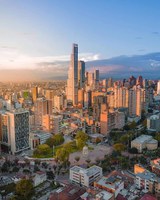
«Colombia’s capital is a city that divides opinion. Its detractors cite poverty, gridlocked traffic and crime, as well as depressingly regular rain, and with over eight million tightly packed inhabitants and some decidedly drab neighbourhoods, Bogotá rarely elicits love at first sight. Given a day or two, however, most people do fall for this cosmopolitan city with its colonial architecture, numerous restaurants and raucous nightlife. In any case, love it or hate it, odds are you’ll have to pass through it at some stage during your travels in Colombia.\n Bogotá is bounded on its western side by the Río Bogotá, and to its east by the Cerro de Monserrate, a mountain ridge topped by a church that can be seen from pretty much anywhere in town, making it a very useful landmark. Thus constricted (although seeping out beyond its traditional boundary on the west side), the city’s expansion has largely been to the north and south. The southern end of town consists of down-at-heel barrios largely inhabited by people who’ve come in from the countryside seeking work. To the north by contrast, Bogotá has swallowed up former satellite towns that have now become pleasant uptown neighbourhoods such as Chapinero – fresh and hilly, full of trendy cafés, and home to the city’s epicentre of gourmet dining, the “Zona G”. At the far northern end of town, Usaquén, formerly a village and indigenous reserve, is now a posh suburb with a popular Sunday market. The city’s oldest neighbourhood, La Candelaria, lies at what was once the junction of two rivers, the Río San Agustín (which now runs under Calle 7), and the Río San Francisco, which still flows through the centre of town to this day, in a channel down Avenida Jiménez. La Candelaria is home to some of South America’s most impressive colonial buildings, and is the neighbourhood where most tourists – and certainly most backpackers – choose to stay. The downtown city centre, though more modern than La Candelaria, gives the impression of having gone slightly to seed, and is nowadays to a large extent upstaged as a commercial and business district by smarter uptown neighbourhoods such as the Zona Rosa. The city’s nightlife zone, Zona Rosa positively heaves with clubs and restaurants, which only really comes to life after nightfall. All over town, one thing you’ll notice is the vibrant and colourful graffiti and street art, a result of the city’s liberal attitude to graffiti, which has made it a mecca for street artists from around the world. Situated on the Sabana de Bogotá, Colombia’s highest plateau and 2600m up in the Andes, Bogotá can be cold and wet year-round. March to May and September to November are the wettest periods, while late December through January is the sunniest time of year. \n Galleries and museums galore, a historic centre that’s well worth a look, vibrant culture and a ton of good food – it must be Bogota, the high-altitude capital of Colombia. This is definitely a cool city that will keep you busy for longer than you’ve got there! Whilst it’s interesting and exciting, crime still is a problem here. Though Bogota has put its worst days of murder and violence behind it, the city still retains a lot of street crime, gangs, and drug trafficking. Luckily, you can avoid these issues by staying in the right area. And in this case, it’s Zona Rosa. Zona Rosa is the dedicated nightlife area with tons of bars, clubs, restaurants, and a heavy police presence. This makes it to one of the safest areas in Bogota. This is where you’ll find most Bogotanos hanging out on the weekends or congregating after work.
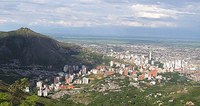
Cali (egentlig Santiago de Cali) er en by i den vestlige delen av Colombia. Den er hovedstad i departementet Valle del Cauca. Byen har et innbyggertall på cirka 2 158 107 (pr. 2008), og er med det landets tredje største by. Byen ble grunnlagt av Sebastián de Belalcázar den 25. juli 1536. Navnet er fra indianerspråket quechua. Cali er en av Colombias viktigste industri- og handelsbyer. Internasjonalt er imidlertid byen mest kjent for Cali-kartellet, et ledende narkotikasyndikat for produksjon og distribusjon av kokain.
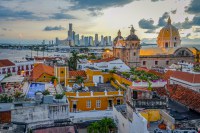
Cartagena er en havneby og provinshovedstad i Bolívar i Colombia. Byen er også kjent under navnene Cartagena de Indias eller La Heroica. Byen har en befolkning på om lag 900 000 innbyggere. Med de omkringliggende områdene er befolkningstallet 1,2 millioner, noe som gjør den til landets femte største storbyområde. Byen ble grunnlagt i 1533 av don Pedro de Heredia, som kalte opp byen etter Cartagena i Spania. Cartagena var et viktig senter for spansk kolonisering av Sør-Amerika, og er i dag fortsatt et viktig økonomisk sentrum samt et populært turistmål. Cartagenas befestede bydel og fort står på UNESCOs verdensarvliste.
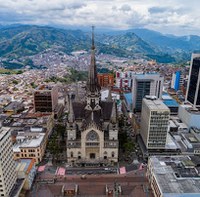
Manizales er hovedstad i departementet Caldas i Colombia og har om lag 480 000 innbyggere. Byen ligger nord i området «Zona Cafetera», nær vulkanen Nevado del Ruiz i en høyde av 2153 meter over havet. Manizales er et viktig utdanningssenter og har flere ulike universiteter. .... \\p ....
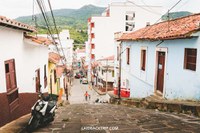
Colombia’s adventure-sports hotspot, SAN GIL is one of the biggest backpacker draws in the country. The town itself is small, friendly and easy to get around (give or take the odd steep hill), but what brings in the visitors is the opportunity it affords to take part in high-adrenaline sports such as whitewater rafting, paragliding and other exciting outdoor activities in the surrounding countryside. San Gil is also an excellent base for day-trips to the colonial town of Barichara and the Parque Nacional del Chicamocha. In the way of sights, on the other hand, San Gil itself doesn’t really have very much. The tree-shaded main square, Parque la Libertad gets quite animated after sundown, when people come to hang out in the cool of the evening. The cathedral, in the northwest corner, is worth a second glance. It was built in the late eighteenth century, in rich, tawny sandstone from Barichara, and its retablo, in white with gold and red trimming, is quite magnificent. \n San Gil is a town municipality in the Department of Santander in northeastern Colombia, located roughly 300 km (192 mi) from Bogotá and 95 km from the department's capital, Bucaramanga. As of 2020, San Gil had a population of roughly 46,000 people within the total municipal area, making it the third largest urban area in the department, after Bucaramanga and Barrancabermeja. Founded in 1689, San Gil is over 300 years old. It was officially named the tourist capital of the region in 2004, thanks to its outdoor activity opportunities such as rafting, caving, kayaking and hiking.

Santa Marta er hovedstad i provinsen i Magdalena i Colombia. Byen ligger ute ved den karibiske kysten og var den første byen som ble grunnlagt i Colombia. Sør for byen ligger de to høyeste fjellene i Colombia, Pico Cristóbal Colón og Pico Simón Bolívar. Santa Marta er et populært turistmål på grunn av de nærliggende strandstedene Taganga og El Rodadero, i tillegg til Tayrona nasjonalpark, som befinner seg øst for byen.
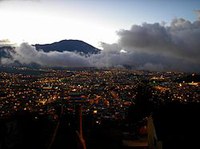
San Juan de Pasto er hovedstad i provinsen Nariño vest i Colombia og har om lag 400 000 innbyggere.[1] Byen ligger i 2527 meters høyde i dalføret «Valle de Atriz» i Andesfjellene nær vulkanen Galeras. Byen ble grunnlagt i 1536 av den spanske conquistadoren Lorenzo de Aldana.[1] Byen fikk navnet «San Juan de Pasto» etter den indianske urbefolkningsgruppen «Los Pastos» som opprinnelig bodde i området. Hvert år arrangeres det et stor karneval i byen som kalles «Carnaval de Blancos y Negros» der egne karnevalsflåter transporteres gjennom byen.[1]
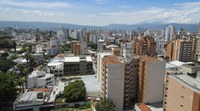
Bucaramanga er hovedstad i departementet Santander øst i Colombia og har om lag 550 000 innbyggere. Byen ligger 959 moh. og har en gjennomsnittsttemperatur på 23 °C. Den ble grunnlagt i 1622. Hele ti universiteter er representert i byen. En internasjonal flyplass, mange hoteller og mange vakre parker og bygninger samt flere turistattraksjoner har sammen med innbyggernes gjestfrihet gjort byen kjent som «La Ciudad Bonita» – Den vakre byen. Byen er også kjent for dens sigarer og en av landets eksotiske matretter, nemlig kjempemaur som man steker og nyter til middagsmat. De viktigste næringene i byen er tekstil- og lærproduksjon, samt hodeplagg.
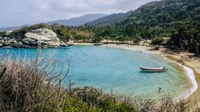
Cabo San Juan del Guía is a beautiful cape with a knockout beach. It's also by far the most crowded area of the park, although lack of road access deters casual day-trippers. The area has a restaurant and a campsite, with hammocks and cabins, in a spectacular lookout on a rock in the middle of the beach. It's possible to spend a very atmospheric night here. Swimming is also possible most of the time, but don't go in too deep.

Tucked against the foot of spectacular mountains, 40km west of Tunja, scenic VILLA DE LEYVA, with its cobbled streets and whitewashed houses is must-see showcase of colonial architecture. It certainly looks and feels immaculately preserved, right down to hand-painted tiles prohibiting horseback riding and car traffic along the main plaza. Founded in 1572, the town is named after the then president of the audiencia (ruling council) of New Granada, Andrés Díaz Venero de Leiva, and the untroubled ambience and mild, dry climate make it a perfect place to relax. The narrow streets throng with day-trippers from Bogotá on weekends, but the rest of the time, this lovely place reverts to its former tranquil, timeless self, and as you sit in the 400-year-old plaza sipping beer or sangría, you’ll be able to appreciate why many describe it as Colombia’s prettiest town.

Medellín er den nest største byen i Colombia. Den befinner seg i Aburrádalen i departementet Antioquia. Selve kommunen hadde 2 441 000 innbyggere i 2013.[1] Med omkringliggende områder er befolkningen på rundt 3,7 millioner, noe som gjør Medellín til en av verdens 100 største byer. Bykjernen preges av skyskrapere, kjøpesentre og et hektisk natteliv. Lenger ut fra bykjerna finner man fattigkvarterer, der det blant annet bor folk som har vært nødt til å flykte fra de væpnede konfliktene andre steder i landet.\n Byen ligger 1500 moh. i den sentrale delen av Andesfjellene. Medellínelva renner gjennom byen. Byen har et temperert klima, hvor temperaturen ligger på om lag 24°C, noe som har gitt byen kallenavnet «den evige vårens by.» Årstidene består av to regnperioder (vinter) og to tørrperioder (sommer) per år. Medellín var lenge kjent som kokainhandelens hovedstad, med påfølgende vold og terror. Etter at flere av de største narkotikakongene (hvor Pablo Escobar var den mest kjente) ble myrdet, har sikkerheten i byen økt. Disse dagene er langt forbi nå som byen opplever sterk økonomisk vekst.
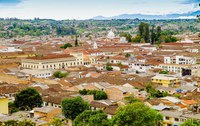
THE COLONIAL CHURCHES OF POPAYÁN The colonial capital of the southwest has retained its all-white, elegant character with handsome churches and mansions close to volcanoes, hot springs and indigenous markets.
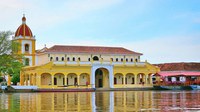
Viewed from the Río Magdalena, the elegantly weathered Baroque churches, palaces and domes of MOMPOX poke out above the palms and whitewashed colonial houses like an eighteenth-century mirage. Troupes of howler monkeys patrol the red-clay-tiled roofs, iguanas doze in trees and clouds of dragonflies hover over fragrant bougainvillea-draped balconies. For many years few places were as redolent of colonial South America, genuinely romantic or simply as magical as Mompox – and still today the spirit of Gabriel García Márquez, whose wife went to high school in the town, seems stronger here than anywhere else in the country. The 1987 movie of Chronicle of a Death Foretold was partly shot here (though the novella was inspired by several places), and Mompox has an important role in The General in His Labyrinth: José Palacios tells Simón Bolívar, “Mompox does not exist. Sometimes we dream about her, but she does not exist.” Bolívar actually raised his army here in 1812, and visited the town six times thereafter (the final stay in 1830 is depicted in the novel). The sense of time warp has faded dramatically in recent years, however, with a series of road bridges connecting Mompox to the rest of the country and a new airport expected to be at full capacity by 2019. As a result tourism is booming and the town is rapidly being renovated and restored to its former glory. One thing that hasn’t changed is the stultifying heat – don’t wander around during the day expecting to find much going on. The secret to appreciating Mompox is doing as the locals do, giving in to the siesta spirit between about 11am and 5pm, and going out when it’s bearable – basically very early morning, when locals start walking their dogs at 5am, or late at night, when you’ll discover something happening on every corner; deserted streets suddenly become colonized by tables, rocking chairs and bars, while kids ride tiny go-karts in the plazas. Many visitors don’t go to bed before 6am.

Home to palm-lined tropical beaches and secluded coves, Parque Nacional Natural Tayrona is one of Colombia’s natural jewels. Located along the Caribbean coastline east of Santa Marta, this national park is a paradise of relaxation, set beneath the backdrop of the looming Sierra Nevada de Santa Marta mountains. Relaxing on sun-soaked beaches or ambling along the jungle trails that edge the coastline are the flavor of the day here, with water currents at most beaches too dangerous for swimmers. To avoid the crowds, head by speedboat to Playa Cristal, an isolated island with pristine waters and gleaming beaches. Time your visit to Tayrona outside of January or February, which are the months when the park typically closes for maintenance.

The heart of La Candelaria is the Plaza de Bolívar, awhirl with street vendors, llamas and pigeons (which you can buy corn to feed) and surrounded by monumental buildings spanning more than four centuries, many covered with political graffiti. In the evenings, street-food carts appear.

OBS OBS: Image or place on map might be wrong. Terminal de Transporte All major inter-city bus services arrive and depart at the large, modern Terminal de Transporte (Diagonal 23 No. 69–60; Image1 423 3600, Imageterminaldetransporte.gov.co), located 8km northwest of the centre in Ciudad Salitre. It’s divided into five colour-coded módulos (units), four for departures and one for arrivals. All arrivals roll up at módulo 5 (purple), which has a tourist information desk. For departures, módulo 1 (yellow) serves destinations south of the capital; módulo 2 (blue) serves places east and west; modulo 3 (red) serves places north of the city, and also handles international departures; módulo 4 (green) is for colectivos. A taxi to the centre costs about C$20,000. Buses from the terminal do not serve the city centre, and the nearest TransMilenio stop, ImageEl Tiempo (served by route #1 to Universidades), is ten blocks away. Services to the south, including Armenia and Cali, stop at the Terminal del Sur, west of the centre on the Autopista Sur, linked to TransMilenio stop ImagePortal del Sur, 700m to its east, by local buses; it can save time to pick up your bus here, but at peak periods buses may already be full when they arrive, which means you won't get a place. **Destinations** Armenia (4–6 hourly; 7hr); Barranquilla (15 daily; 18hr); Bucaramanga (3–4 hourly; 10hr); Cali (4–5 hourly; 10hr); Cartagena (19 daily; 22hr); Cúcuta (10–12 daily; 15hr); La Plata (for Tierradentro) (7 daily; 9hr); Lima, Peru (3 weekly; 72hr); Manizales (24 daily; 8hr); Medellín (5–6 hourly; 9–10hr); Pasto (8 daily; 22hr); Pereira (2–4 hourly; 9hr); Popayán (6 daily; 12hr); Quito, Ecuador (3 weekly; 28hr); San Agustín (7 daily; 12hr); San Gil (3–4 hourly; 7hr 30min); Santa Marta (11 daily, mostly overnight; 18hr); Tunja (3–4 hourly; 3hr).
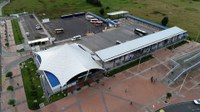
NB: Image might be wrong. Buses leave from here for Zipaquirá, Suesca and Guatavita, with one-stop TransMilenio transit to the nearby Terminal del Norte, the best place to pick up buses for Tunja. Buses also run to Guatavita from Cra 13, at C 72. Destinations Guatavita (every 15min; 1hr 30min); Suesca (every 15min; 1hr); Tunja (3–4 hourly; 2hr 30min); Zipaquirá (every 5–10min; 1hr).

Located in the Candelaria district, the historic center of Bogota, Masaya Hostels Bogotá is an immersion inside the Colombian culture. Dorms: 100-150 NOK You will be welcomed in a big colonial house with a typical decor. In order to enjoy fully your local experience, Masaya offers you multiple activities: salsa classes, live music, local artists in live and expositions... Masaya staff will provide you all information about excursions, tours and cultural events in and around the city. Three comfortable patios allow you to relax in hammocks and to meet Colombian people and foreigners. Guests have at their disposal all amenities needed: Free Wifi everywhere, fully equipped kitchen, TV room, computers with internet, pool table, ping-pong table... Masaya Hostel Bogotá has a 24h front desk service, laundry service and a bar. Offering a variety of private rooms and single beds in dormitories, Masaya hostel caters for travelers, families and groups of friends. The rooms come with either a private or shared bathroom, and Standard and Deluxe private rooms have cable television. In the evening, you can discover our typical bar with Colombian and international flavors. Masaya's location is perfect to discover all principals' attractions of the capital: Cerro Monserrate Hill (2 km), Gold museum (500m), Botero museum (500m), and Chorro de Quevedo the artist centre (50m).
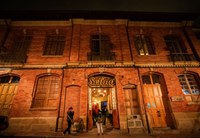
The cultural crown jewel of the Andes, Bogotá is a massive, bustling mecca of art, history, cuisine, and nightlife, driven by a passion for modern, forward-thinking. From its famous foodie heaven Zona G to its huge offering of contemporary art galleries to the panoramic views from the surrounding mountains, the revitalized Bogotá is a haven for travelers and adventurers from all walks of life. The ultimate Bogotá experience starts with the right location, and Selina Bogotá is in the historic city center of La Candeleria, a hop, skip, or funicular ride away from everything. Our goal is to help you get to know this awesome city like a new friend by connecting you with fellow guests on the same track, as well as a variety of local ventures. We offer both private and shared dorms, perfect for every guest and every budget, plus a shared kitchen space. Shoot some pool and catch up with your travel companions in our common room, or visit the Wi-Fi kitted-out co-working space to stay plugged-in and productive. No matter what's on your travel to-do list, you can relax, reload, and re-inspire on your own terms. Selina Bogota Policies & Conditions: Check in from 15:00 to 23:00 . Check out before 11:00 . Cancellation policy: 48 hours before arrival. In case of late cancellation or no show, the first night of your booking will be charged. This action is not fraudulent. Payment upon arrival by cash, credit cards, debit cards. This property may pre-authorise your card before arrival. Taxes not included - 19.00% (This tax only applies for colombian residents. Foreigners are required to show migration stamp) Breakfast not included. General: No curfew. Pet friendly. Child friendly. Non smoking. For reservations of more than 12 pax, special, group-exclusive policies may apply, different from single-reservation policies. According to seasonality and/or demand, a pre-payment of 50% to 100% of the total booking amount might be required. The hotel will try to contact the guest and if a reply with payment possibility is not received, the booking could be cancelled

Granada Hostel displays all its original features from early XX Century, while providing an extra-comfortable stay with newly fitted bathrooms, range elite mattresses and relaxing showers with a refurbished high-pressured system, ensuring hot water 24-7 (rare in the historical centre!). While enjoying the historical experience, you can mingle in the patio bar, read a book on the hammocks or take a break in the hammock floor net… a unique experience! The house is full of social areas where you can enjoy meeting new friends during your trip. All rooms are all unique in size and style, displaying the original house layout. Rooms are clean and neat, and as a recently opened hostel, everything is brand new. Heating systems, lighting and ventilation are ecofriendly, in line with our core values. Granada Hostel is a great choice for travellers interested in scenery and old-town exploration. Museo del Oro, Quevedo jet, Museo de Botero, Plaza de Bolivar, Casa de la Moneda, Museo del 20 de Julio and many other historical attractions are within a few blocks. Tourist highly value strolling and admiring the republican and colonial architecture of the area. Granada Hostel Policies & Conditions: Cancellation policy: 72h before arrival. In case of a late cancellation or No Show, you will be charged the first night of your stay. Check in from 15:00 to 23:00 . Check out from 07:00 to 11:00 . Payment upon arrival by cash, credit cards, debit cards. This property does not accept Diners card. This property may pre-authorise your card before arrival. Taxes not included (19% for Colombia residents only). Breakfast not included (11.000 COP per person per day). General: Reception 24 h. No curfew. We do not accept customers younger than 16 years of age. Smoking is only permitted in specially designated smoking area
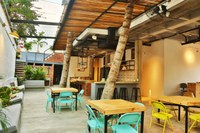
Our property has a privileged view to the castle of San Felipe de Barajas and is a few minutes walk from the main tourist points of the historical center, like the Museum of the Gold of Cartagena, the statue of the India Catalina, the square of the Most Holy Trinidad and Bolivar Park. Santuario Getsemaní Hostel is located in the beautiful and bohemian neighborhood Getsemaní at Cartagena de Indias, at Pedregal Street. The shared rooms are made by cubicles and a blackout achieving a light and sound insulation, giving an excellent experience of privacy. Each cubicle is equipped with its own light, bedside table, shelves, safe to use with padlock, electric socket with USB and closet for storing luggage with padlock.
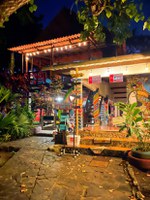
The Australian owner is a mine of information about the town and it’s an excellent place to organize your outdoor adventures, with lots of backpacker-friendly creature comforts to boot – jacuzzi anyone? Dorms C$22,000, doubles C$60,000

On the main square, with a terrace overlooking the square and a small rooftop pool, not to mention two kitchens and an easy-going vibe. A small breakfast is thrown in. Dorms C$25,000, doubles C$110,000
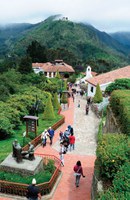
Cerro de Monserrate • Santuario Mon 11.30am–5pm, Tues–Sun 8am–5pm • Free •

The Cranky Croc backpackers hostel in the historic centre of Bogota is the ideal place to relax and meet other travelers. Located nearby to Bogota most interesting sites, museums & nightlife, this beautifully remodeled colonial house features outdoor patios, lounge with big screen TV, netflix and directv, bar & restaurant, fully equipped guest kitchen, huge TV for sports, WiFi & internet terminals, 24 hour hot water, lockers with electrical sockets & many hooks in the dorms, tourist information, big beds with duvets & reading lamps, towels included, free luggage storage, laundry service & many social events.